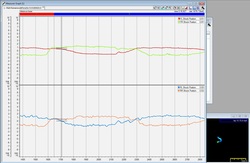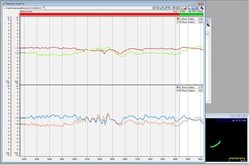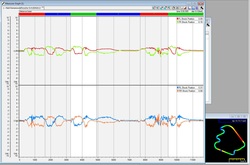Shocking Help II
Ever notice one car doesn’t look as good over the bumps as another. Most times we chalk it up to better dampers, different suspension designs, or even the driver’s skill and/or track position when they hit the bumps. While those things certainly play a major role in how the car looks and handles, sometimes there is more at play.
Check out this trace and see what you notice. The top graph is the front shock positions and the bottom is the rear shock positions.

When the shock position starts to go into compression (up in the graph), the lines start to flatten out and not show as much small amplitude bumps. The rear, while moving a similar amount, still has a lot of small movements in the shock positions. You see this as the rear shock still plateaus, but has lots of small movements versus the front that seems to flat line. This is a result of the front suspension going into the bump stops. The front suspension gets into the bump stops which starts to increase the effective springs rates at an increasing rate.
When we zoom into a smaller one corner section, we can see the same thing happening. You can see the front shock position move to a certain position and then it doesn’t change much. At the rear, we can see that even when it goes approaches the limit of how compressed it will be, it still has a number of small movements. Those small movements are the car absorbing small road irregularities when loaded for a corner.

When we zoom into a smaller one corner section, we can see the same thing happening. You can see the front shock position move to a certain position and then it doesn’t change much. At the rear, we can see that even when it goes approaches the limit of how compressed it will be, it still has a number of small movements. Those small movements are the car absorbing small road irregularities when loaded for a corner.

If we zoom into a portion of the graph right before a corner when the front suspension hits the bump stops, we can see the it does move similar to the rear with lots of little movements in the overall trend. In this center of this graph, we can see that when the front suspension is close to the 0 position (center of the graph) it has similar little bumps to the rear.
When analyzing your data, you have to compare what you are actually getting to what you would expect. In this case, you expect the suspension to always be absorbing bumps, so when it stops doing that, you have to look at why. This applies to many areas, like lateral acceleration to each side – they should be roughly equal for equal turns, engine speed to wheel speed – the clutch shouldn’t be slipping, steering angle to lateral G – a rough over/understeer measurement, and many more items. The more ways you can dig into your data, the more you will get out of it and the faster you can go.
When analyzing your data, you have to compare what you are actually getting to what you would expect. In this case, you expect the suspension to always be absorbing bumps, so when it stops doing that, you have to look at why. This applies to many areas, like lateral acceleration to each side – they should be roughly equal for equal turns, engine speed to wheel speed – the clutch shouldn’t be slipping, steering angle to lateral G – a rough over/understeer measurement, and many more items. The more ways you can dig into your data, the more you will get out of it and the faster you can go.
Jan 26th 2021
Recent Posts
-
Position Sensors
So you want to know where something is? There are a lot of options! In motorsports we measure the po …Feb 2nd 2025 -
Pressure Sensor Info
So you want to measure a pressure? Gauge or absolute? Air or liquid? If air, gauge, absolute, or dif …Jan 22nd 2025 -
Driver health, monitoring, and performance
I was surfing Instagram and saw Dr. David Ferguson, of the Spartan Motorsports Performance Lab, post …Mar 22nd 2022


